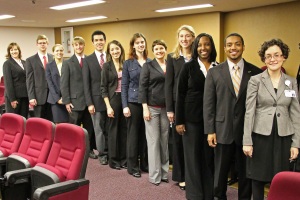 Four health science students from Belmont, three from the School of Nursing and one from the College of Pharmacy, recently competed in the annual Interprofessional Clinical Case Competition (ICCC) sponsored by the Meharry-Vanderbilt Alliance in Nashville.
Four health science students from Belmont, three from the School of Nursing and one from the College of Pharmacy, recently competed in the annual Interprofessional Clinical Case Competition (ICCC) sponsored by the Meharry-Vanderbilt Alliance in Nashville.
The four students, Danielle Degati, Kate McFarland and Courtney Thompson representing RN nursing and Shanna Harris representing pharmacy, are on teams joining pre-professionals from ten different healthcare disciplines. Other team members include medical and dentals students from Meharry Medical College; students from medical, nurse practitioner, law, dietetic, divinity, and speech and hearing pathology programs at Vanderbilt University; and pharmacy and graduate social work students from the University of Tennessee.
Degati, a senior, said, “I think the greatest part of this competition is feeling like I can say that I now understand how multi-disciplines work together to accomplish one goal… It has been eye opening, and I feel comfortable approaching other health care professionals in the hospital, not just nurses; without this experience, I’m not sure that comfort would have come to me so soon.”
The competition, based on the University of Texas Houston model, promotes an interdisciplinary learning experience where students learn to appreciate the value of various team members involved in reaching optimal patient outcomes. There are three interdisciplinary student teams, each with eleven student participants.
Thompson, also a senior, noted, “Participating in the ICCC has given me a better comprehensive view of how in depth patient-centered care goes. It is complex physiologically, emotionally, spiritually and cognitively and one person could not offer the knowledge or manpower to completely care for any patient. I am very proud to have had this experience because I have learned so much about other disciplines and because I have also learned how I work as a team member. I am sure these lessons will be invaluable assets I can use throughout my career.”
Students were chosen to represent their school or program by their dean or program director, based on the student’s openness to the value of an interdisciplinary approach and the student’s ability to function on a team. The student must be in the final year of training. The overall competition took about 6 weeks from orientation to public competition.
At each step of the competition, the work of the team was reviewed and scored by faculty from each discipline. An important component of the competition occurred in a simulation exercise at the Vanderbilt Center for Experiential Learning and Assessment (CELA) where patient actors represented the details of the patient(s) in the case. Several members of each team had opportunity to interview these patients while other team members observed via real time video. Faculty jurors also observed and judged the interview and team collaboration process.
Also participating in the competition as a part of a team of interdisciplinary faculty are Dr. Beth Hallmark, Director of Simulation at Belmont, and Sandra Rosedale, Clinical Coordinator in the School of Nursing. The team, which also includes faculty from Meharry Medical College, Vanderbilt University and University of Tennessee, has worked together for several months to develop details of a clinical case that will provide meaningful opportunities to highlight teamwork and also the importance and value of each discipline.
Current healthcare research supports the integration of interprofessional education (IPE) into all healthcare programs. In 2011, Core Competencies for Interprofessional Collaborative Practice were developed in collaboration with the American Association of Colleges of Nursing, Association of American Medical Colleges, American Dental Education Association, Association of Schools of Public Health, American Association of Colleges of Pharmacy, and the American Association of Colleges of Osteopathic Medicine.
The Meharry-Vanderbilt Alliance was established in 1999. Joint research grants in the alliance now total more than $267 million, with annual joint grants exceeding $40 million each year.
